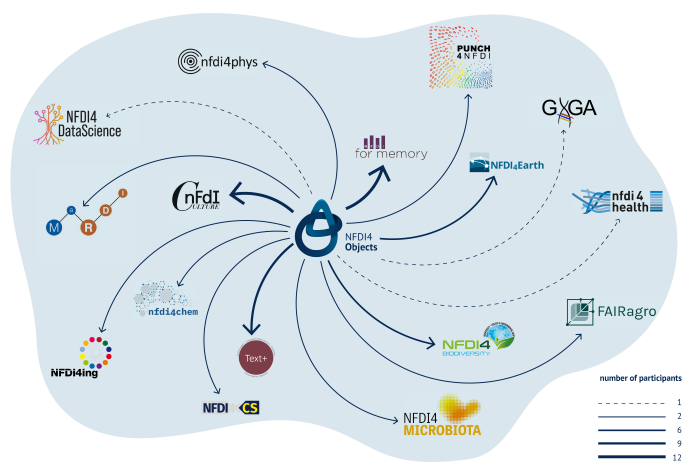NFDI4Objects in the NFDI
About the National Research Data Infrastructure (NFDI)
The National Research Data Infrastructure (NFDI, Nationale Forschungsdateninfastruktur) is dedicated to systematically identifying, networking, and sustainably making research data resources in Germany available as a common good for future research.
Relevant data are to be preserved and provided in a permanent knowledge repository following the FAIR principles (Findable, Accessible, Interoperable, Reusable). This creates the foundation for excellent future research and significant innovation in science and society.
To achieve these goals, and following a recommendation by the German Council for Scientific Information Infrastructures, the Joint Science Conference (GWK) decided to fund the NFDI under the Federal-Länder-Agreement of 26 November 2018 for establishing and promoting a National Research Data Infrastructure.
To coordinate the development of the NFDI, the non-profit association National Research Data Infrastructure (NFDI) e.V. was founded in 2020, headquartered in Karlsruhe. The association has its own governing bodies and structures.
NFDI4Objects is a consortium funded under the Federal-Länder-Agreement on the NFDI, and on the other hand, as well as a sub-division of the NFDI e.V. association.
The Federal-State Agreement and NFDI4Objects
Under the Federal-Länder-Agreement (Bund-Länder-Vereinbarung, BLV), the German federal and state governments are providing up to 90 million euros annually for project funding between 2019 and 2028. The establishment of the NFDI is being undertaken by subject-specific consortia organised by the academic communities themselves, enabling them to address the specific needs of research data management within their disciplines.
Following three rounds of proposals, the NFDI now includes 26 consortia and the union of consortia Base4NFDI. These consortia were selected by the Joint Science Conference in a science-led process coordinated by the Deutsche Forschungsgemeinschaft (DFG, German Research Foundation). They cover a wide range of academic disciplines: from cultural, social, and humanities disciplines to engineering, life sciences, and natural sciences.
NFDI4Objects is one of the consortia selected in the third round and has been funded under the Federal-State Agreement since March 2023.
The Association National Research Data Infrastructure e.V.
The non-profit association National Research Data Infrastructure e.V. (NFDI e.V.), founded in 2020, coordinates the development and establishment of the NFDI. Its governing bodies include the Directorate, the Consortia Assembly, the Board of Trustees, the Member Assembly, and the Scientific Senate. The association’s administrative office is located in Karlsruhe.
Membership of NFDI e.V. is generally open to all interested organisations and institutions, especially those already participating in an NFDI consortium or expected to contribute to achieving the association’s objectives.
The work of the individual NFDI consortia on research data management across different disciplines involves several cross-cutting topics that must be addressed beyond the boundaries of individual consortia. This work takes place in the association’s sections, where members collaborate to develop standards, metadata standards, and formats.
The Scientific Senate of the association has established the following sections:
- Common Infrastructures (section-infra)
- Ethical, Legal and Social Aspects (section-ELSA)
- (Meta)data, Terminologies, Provenance (section-metadata)
- Training & Education (section-edutrain)
- Industry Engagement (section-industry)
More information about these sections can be found on the NFDI e.V. website.
Within NFDI e.V., the consortia funded under the Federal-Länder-Agreement are legally dependent sub-divisions as defined by the association’s statutes. The members of NFDI4Objects represented in NFDI e.V. form the consortium of the same name. Within the association, NFDI4Objects is represented by its elected spokesperson and deputy spokesperson. Moreover, many representatives from the institutions involved in the consortium actively participate in the sections.
Collaboration of NFDI4Objects with Other NFDI Consortia
As a multidisciplinary consortium, NFDI4Objects has many points of contact with other consortia. There are numerous overlaps in data collection and the resulting research data with natural and life sciences consortia in the NFDI, such as NFDI4Earth, NFDI4Biodiversity, and FAIRagro. Examples include data from landscape surveys, soil sample analyses, ancient genome data, and studies of animal bones or plant remains.

Humanities@NFDI (“Memorandum Group”)
Humanities@NFDI (“Memorandum Group”) is a collaboration of the humanities and cultural studies consortia within the National Research Data Infrastructure. To address the diverse needs of the highly differentiated humanities research landscape, the NFDI consortia initiatives NFDI4Culture, Text+, NFDI4Memory, and NFDI4Objects adopted a Memorandum of Understanding in 2019, which was updated in 2020.
![The coordinators of the consortia NFDI4Culture (Sarah Pietroff), NFDI4Objects (Christin Keller), NFDI4Biodiversity (Barbara Ebert), NFDI4Memory (John Wood), Text+ (Lukas Weimar) and FAIRagro (Carsten Hoffmann) at the NFDI4Objects Community Meeting in Mainz 2024 [from top left to bottom right]. As a multidisciplinary consortium, NFDI4Objects has many overlaps with other NFDI consortia, as can be seen in this graphic. Exchange takes place regularly, for example here at our Community Meeting 2024](/assets/img/img_4470.jpg)
The four consortia aim to support each other constructively in their work. Through the memorandum, they have also committed to boost a cultural change in the handling of research data within their respective communities.
The Humanities@NFDI cooperation therefore offers a wide range of workshops, training sessions, services, and events and closely coordinates its activities in the sections, working groups, and committees of NFDI e.V.
If you wish to contact Humanities@NFDI, please write to: humanities@lists.nfdi.de.
BASE4NFDI
The union of consortia Base4NFDI integrates and establishes basic services as shared, interoperable solutions for the entire NFDI. To this end, existing services are adapted or further developed so that they can be used by researchers from other disciplines. This helps to avoid parallel developments, as many research areas have similar requirements for certain research data management services. NFDI4Objects actively contributes to the development of these basic services and supports their integration into the NFDI4Objects service portfolio.